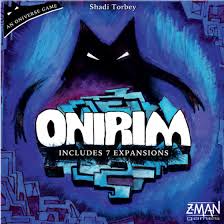Comic books and superheroes have always been a part of my repertoire. I read whatever I could get in my hands. It was the tagline of one of these books that drew me in. Daredevil: The man without fear. I was dumbstruck by the thought. I was scared of everything, so I dreamed about not feeling that heart-racing, sweaty-palmed angst ever again. I’ve since realized that not having any fear has its own dangers. Daredevil’s fearlessness often saw him broken and bloodied, and he was a superhero. A healthy level of fear helps me do what I need to do and still come home safe at the end of the day. But where is that line? Where is the point on the spectrum that fear goes from reasonable response to dangers and risks to a crippling anxiety that makes it so we never leave the house? As I sat at my desk shuffling, dealing, and reshuffling cards, I contemplated that question. Onirim had me asking it every time my hand hovered over the deck to draw the next card, knowing that there were still nightmares yet to be revealed.
Gaming Solo
 Solo gaming has only been a recent phenomenon for me. When I started exploring the genre beyond the myriad variations on solitaire, one of the first titles I was recommended was Onirim. This game had such a strong place in solo gaming that it has since spawned an entire series of games – referred to as the Oniverse. It proved to be a simple game. It’s a deck of cards in four colors (red, blue, green, and beige), in three suits (suns, moons, and keys), with two “door” cards for each color. Players deal out a hand of five cards and try to unlock doors by playing three cards of the same color in a row. Naturally, it’s not as simple as it sounds.
Solo gaming has only been a recent phenomenon for me. When I started exploring the genre beyond the myriad variations on solitaire, one of the first titles I was recommended was Onirim. This game had such a strong place in solo gaming that it has since spawned an entire series of games – referred to as the Oniverse. It proved to be a simple game. It’s a deck of cards in four colors (red, blue, green, and beige), in three suits (suns, moons, and keys), with two “door” cards for each color. Players deal out a hand of five cards and try to unlock doors by playing three cards of the same color in a row. Naturally, it’s not as simple as it sounds.
The first challenge to unlocking doors is that you can’t play the same suit next to each other. Suns can’t be played next to other suns, etc. This restriction complicates your play choices, especially when you are staring down a hand entirely made up of one suit. Planning out which color to lead with and the order in which the cards are played can be stressful, especially since the suits are not evenly dispersed – suns being the most prevalent while there are only a few keys of each color. You may need to get rid of a card in order to find what you are looking for, but getting rid of a moon may give you pause.
As frustrating as this can be, the cards that will make the hairs on the back of your neck stand on end are the nightmare cards sprinkled throughout the deck. Each time a nightmare is drawn, the player will have to choose from a collection of terrible options. They can discard their entire hand, they can discard the top five cards from the deck – sight unseen, or they can take one of their unlocked door cards and return it to the deck. The best case scenario when facing a nightmare is to sacrifice a key card. Yet this requires you both have a key in hand to use, and you need to get rid of the most powerful card in the game.
Keys are multi-functional. Not only can they be used as part of a three card set to unlock a door, but they can unlock doors on their own. If a door card is drawn when you have a key of the same color, you can simply discard that key by itself to unlock it. Even when keys are discarded outside of nightmares, they allow the player look at the next five cards on the draw deck, rearrange them in any order, and discard one of their choice. This is a great way to weed cards you don’t want or set up future plays. So even though they are the best answers you have – they will disappear when you need them most.
No matter how it happens, if you are able to unlock all the doors in the deck before you run out of cards, you are the winner. You have successfully navigated the dream world and come out the other side. If the deck is empty and there are doors that remain locked, you are stuck. The game is over. The nightmares have won.
Fear Ever-Present
 My first few games of Onirim did not go well. I was so careful. I’d set up two cards without any problem, but would ditch card after card into the pile trying to find the third one that refused to appear. Every time I convinced myself that I was due, the next card surely had to be the card I needed, I’d reveal the nightmare and fight back a scream. I began hoarding keys, refusing to use them for anything other than protection. Confident in my safety, I started taunting nightmares with a “come get me, bro” swagger right up to the point that I’d draw two of them back to back. Occasionally I’d win the day, but it was not by my own doing. I was convinced the nightmares wanted to give me just enough hope to make stomping my dreams fun again.
My first few games of Onirim did not go well. I was so careful. I’d set up two cards without any problem, but would ditch card after card into the pile trying to find the third one that refused to appear. Every time I convinced myself that I was due, the next card surely had to be the card I needed, I’d reveal the nightmare and fight back a scream. I began hoarding keys, refusing to use them for anything other than protection. Confident in my safety, I started taunting nightmares with a “come get me, bro” swagger right up to the point that I’d draw two of them back to back. Occasionally I’d win the day, but it was not by my own doing. I was convinced the nightmares wanted to give me just enough hope to make stomping my dreams fun again.
I wasn’t enjoying myself. I wondered what I was doing wrong. Questioned the sanity of those who said Onirim was one of the premier solo games on the market. I was about to give up and give the nightmares their victory, but sometimes it’s when we can’t get any lower that we see what the light. I was letting the deck paralyze me. I couldn’t win because I refused to actually play.
I let myself leave two card matches behind when the third was nowhere in sight. I wouldn’t throw my keys around like Oprah on sweeps week, but I started letting myself throw a few to the discard to set up for the door I was looking for and one to follow it. I stopped worrying about nightmares and started taking more risks. The nightmares were no longer the terrible beasts waiting to pounce inside the deck, they were just an annoying hurdle I’d jump. I started winning.
Fear has a place. When I only had two moons left in the deck and one of them was sitting in my hand, it made me weigh my options instead of just running ahead. I’d hold a key back in my hand when I was looking for a card, but then ditch it the moment a second one came into view so I would still be covered. While my percentage has improved dramatically, I still lose about half the games I play, so the hairs on the back of my neck still get jumpy. I still bite back the occasional curse when an inopportune nightmare comes to call. But I’m in the game now. I’d never win that other half if I was still holding out for bad cards.




